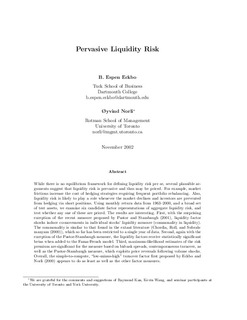Pervasive liquidity risk
Working paper
Permanent lenke
http://hdl.handle.net/11250/163679Utgivelsesdato
2002-11Metadata
Vis full innførselSamlinger
- Discussion papers (FOR) [566]
Sammendrag
While there is no equilibrium framework for defining liquidity risk per se, several plausible arguments suggest that liquidity risk is pervasive and thus may be priced. For example, market frictions increase the cost of hedging strategies requiring frequent portfolio rebalancing. Also, liquidity risk is likely to play a role whenever the market declines and investors are prevented from hedging via short positions. Using monthly return data from 1963–2000, and a broad set of test assets, we examine six candidate factor representations of aggregate liquidity risk, and test whether any one of these are priced. The results are interesting. First, with the surprising exception of the recent measure proposed by Pastor and Stambaugh (2001), liquidity factor shocks induce co-movements in individual stocks’ liquidity measure (commonality in liquidity). The commonality is similar to that found in the extant literature (Chordia, Roll, and Subrahmanyam (2000)), which so far has been restricted to a single year of data. Second, again with the exception of the Pastor-Stambaugh measure, the liquidity factors receive statistically significant betas when added to the Fama-French model. Third, maximum-likelihood estimates of the risk premium are significant for the measure based on bid-ask spreads, contemporaneous turnover, as well as the Pastor-Stambaugh measure, which exploits price reversals following volume shocks. Overall, the simple-to-compute, "low-minus-high" turnover factor first proposed by Eckbo and Norli (2000) appears to do as least as well as the other factor measures.
Utgiver
Norwegian School of Economics and Business Administration. Department of Finance and Management ScienceSerie
Discussion paper2002:15
